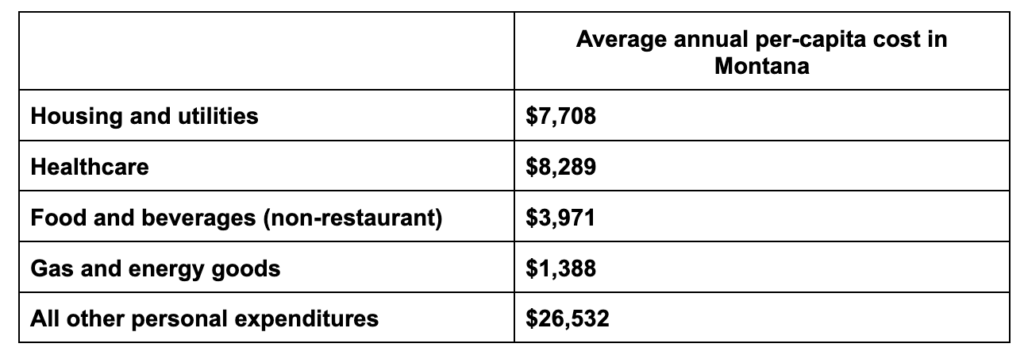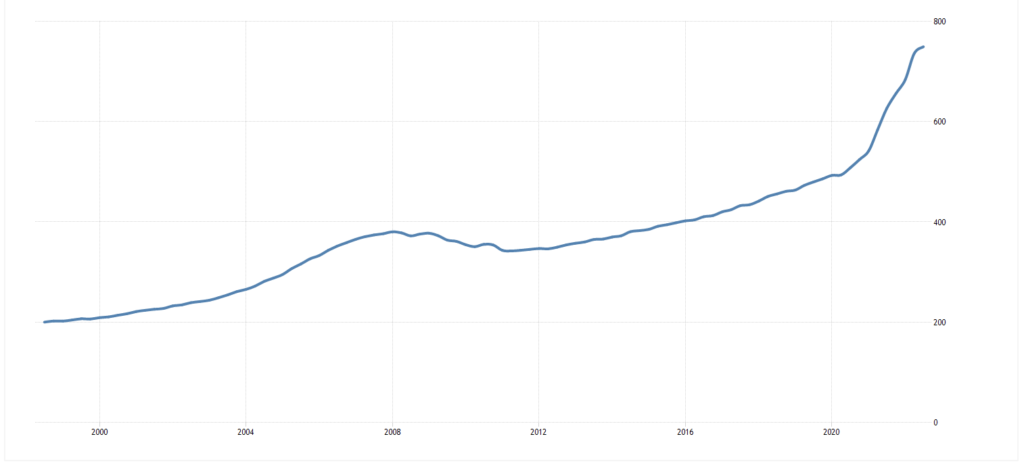Montana’s open space, wild nature, and big skies draw visitors and relocators year-round, boosting real estate demand and housing inflation. But Montana has no sales tax and has no large cities.
So, why is Montana so expensive?
It turns out, some unique factors contribute to why Montana is so expensive. In this article, we break them down for you.
In this article:
- Cost of living in Montana – Quick look
- Rising housing costs – How it impacts living costs in Montana
- What pushes Montana housing prices up?
- Why does the housing boom drive the price of general goods and services up?
- Why is Montana so expensive? Final answer
Cost of living in Montana – Quick look
According to SoFi, the average cost of living in Montana is $47,887 per year, making Montana the 15th most expensive state in the U.S. and more expensive than half of the country.
Here is a quick breakdown of annual living costs in Montana according to 2021 data:

By the way, if you’re considering moving to the mountain states, but you’re not sure which one to choose, these articles may help:
In each one, we compare multiple aspects of life in each state, including living costs.
And if you’re considering where to live in Montana, consider reading our article detailing the best places to live in Montana.
To fully answer the question of “Why is Montana so expensive?”, we need to look at the housing market. Rising house prices is the core factor behind why Montana is so expensive.
Why is Montana so expensive? Rising housing costs
Housing costs in Montana have risen steadily since the 1990s. According to Trading Economics, the House Price Index across the state of Montana has more than tripled since 2000:

In the 1990s, home prices rose an average of 7.1% until the 2008 global financial crisis curbed this growth. Since the recession, housing prices in Montana have continued to rise at an average of 4.1% annually.
But why is this happening? And why does this drive the cost of living up statewide?
Let’s answer the first question. Then, we’ll answer the second.
What steadily pushes Montana’s housing prices up?
It all comes down to supply and demand, but what drives supply and demand in Montana is unique.
Basic economic theory would predict that as housing prices increase, developers would create more housing until costs come in line with local wages. But, in many places in Montana, this isn’t the case.
Here’s why:
1. Montana’s natural beauty creates high demand
Firstly, housing demand in Montana is high due to the state’s natural beauty. With such beautiful natural parks and pleasant towns, it’s understandable many people consider moving to the state.
Montana’s beautiful landscapes attract people from all over the world seeking a pleasant setting to live in.
2. Demand was inflated during the COVID-19 pandemic
Montana saw an unusually large surge in housing prices throughout the pandemic. People see Montana as a place where they can isolate themselves from threats like Covid-19.
According to NBC Montana, the median sales price for a home in Gallatin County rose from $384,000 before the pandemic to $479,900 in August, 2019 – a 25% increase in eight months.
As employers increasingly offer remote work opportunities, more and more people are eyeing Montana as a place to live, far from the crowds. Meanwhile, supply remains much lower than demand.
3. Fear, regulation, and geography keep supply low
Three primary factors influence housing supply in Montana.
Firstly, As demand rapidly rises, supply lags behind, and people hesitate to sell their homes as they fear they’ll struggle to find another one.
Secondly, government regulations in Montana cities, such as sidewalk requirements and density restrictions, may make it more difficult for developers to move in and build more housing.
Lastly, some areas of Montana are just off-limits for development. In fact, 29% of Montana consists of federally managed land, wetlands, and agricultural land, all of which cannot be developed. While this may be frustrating as living costs rise, Montana regulators regularly work to strike a balance between preserving the state’s open spaces and mitigating rising housing costs.
High demand plus low supply is a perfect recipe for rising housing prices, which helps explain why Montana is so expensive. But how do housing prices drive the cost of general goods and services up in Montana?
Why does the housing boom drive the price of general goods and services up?
In short, Montana’s housing boom has a ripple effect on the state economy.
Rising house prices generally lead to increased consumer confidence and spending, which pushes economic growth. Rising house prices can also redistribute wealth within the local economy, which increases homeowner wealth and can further boost consumer spending.
According to Zippia, Montana now ranks 36th out of all U.S. states for grocery costs. Not bad, but in popular cities like Bozeman, the cost of groceries is 7.6% higher than the national average.
Why is Montana so Expensive? Final answer
Why is Montana so expensive? Extremely high housing demand and limited supply have consistently driven Montana housing prices up for decades. Rising housing prices have a ripple effect on the rest of the economy and consumer spending increases in certain sectors of society.
Nonetheless, the cost of living in many of Montana’s cities and towns is well below the national average. So, while certain places in the state are expensive, it may not be accurate to say that Montana is expensive, statewide.
FAQ – Why is Montana so expensive?
Below are answers to commonly asked questions related to why Montana is so expensive.
Is Montana an expensive state to live in?
Overall, Montana is a moderately expensive state to live in. According to SoFi, Montana is the 15th most expensive state to live in, but living costs vary widely between cities.
Why are Montana home prices so high?
Montana home prices are so high because demand for homes far exceeds supply. Demand for housing in Montana is driven by the state’s attractive natural landscapes, lack of crowds, and regulatory limits on development, which limits supply.
Isn’t Montana a poor state?
Montana has the 10th lowest average household income of all 50 U.S. states.

